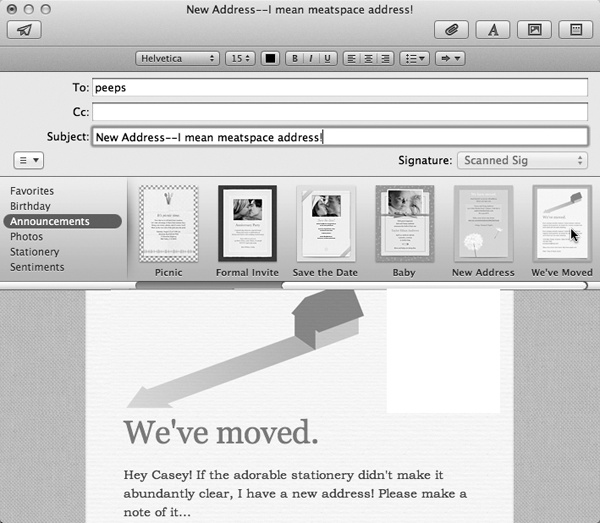Rich Text—and even plain text—messages are fine for your everyday personal and business correspondence. After all, you really won’t help messages like, “Let’s have a meeting on those third-quarter earnings results” much by adding visual bells and whistles.
But suppose you have an occasion where you want to jazz up your mail, like an electronic invitation to a bridal shower or a mass-mail update as you get your kicks down Route 66.
These messages just cry out for Mail’s Stationery feature. Stationery means colorful, predesigned mail templates that you make your own by dragging in photos from your own collection. Those fancy fonts and graphics will certainly get people’s attention when they open the message.
Note
They will, that is, if their email programs understand HTML formatting. That’s the formatting Mail uses for its stationery. (If HTML rings a bell, it’s because this HyperText Markup Language is the same language used to make Web pages so lively and colorful.)
It might be a good idea to make sure everyone on your recipient list has a mail program that can handle HTML; otherwise, your message may look like a jumble of code and letters in the middle of the screen.
Here’s how to make a stylized message with Mail Stationery:
Create a new message.
Click File→New Message, press ⌘-N, or click the
 button on the Mail window toolbar.
button on the Mail window toolbar.On the right side of the toolbar in the New Message window, click the
 button.
button.A panel opens up, showing you all the available templates, in categories like Birthday and Announcements (Figure 11-6).
Click a category, and then click a stationery thumbnail image to apply it to your message.
The body of your message changes to take on the look of the template.
If you like what you see, click the
 button on the toolbar
again to fold up the stationery-picker panel.
button on the toolbar
again to fold up the stationery-picker panel.Now, Apple’s canned stationery looks fantastic. The only problem is, the photos on most of the templates are pictures of somebody else’s family and friends. Unless you work for Apple’s modeling agency, you probably have no clue who they are.
Fortunately, it’s easy enough to replace those placeholder photos with your own snaps.
Click the Photo Browser icon (
 ) on the toolbar to open up a palette that
lists all the photos you’ve stored in iPhoto, Aperture, and Photo
Booth.
) on the toolbar to open up a palette that
lists all the photos you’ve stored in iPhoto, Aperture, and Photo
Booth.Tip
If you don’t keep your pictures in any of those programs, you can drag any folder of pictures onto the Photo Browser window to add them.
Now you can drag your own pictures directly onto Apple’s dummy photos on the stationery template. They replace the sunny models. You don’t have to know a lick of HTML to use the templates—it’s all drag, drop, and type, baby.
To resize a photo in the template, double-click it. A size slider appears. Drag the mouse around the photo window to reposition the picture relative to its frame.
Select the fake text and type over it with what you really want to say.
As you type, your words are autoformatted to match the template design.
Once you’ve got your message looking the way you want it,
address it just as you would any other piece of mail, and then click the Send ![]() button to get it on its way.
button to get it on its way.
Tip
You’re not stuck with Apple’s designs for your stationery templates; you can make your own. Just make a new message, style the fonts and photos the way you want them, and then choose File→Save as Stationery. You can now select your masterwork in the Custom category, which appears down at the end of the list in the stationery-picker panel.
If you decide the message would be better off as plain old text, click Show Stationery on the message window. In the list of template categories, click Stationery and then Original to strip the color and formats out of the message.
Tip
If you find you’re using one or two templates a lot (if, for example, all your friends are having babies these days), drag your frequently used templates into the Favorites category so you don’t have to go wading around for them.
To remove one from Favorites, click it, and then click the
![]() in the top-left corner of the
thumbnail.
in the top-left corner of the
thumbnail.

